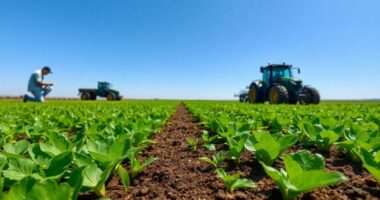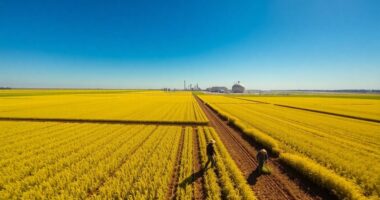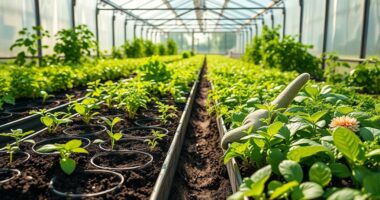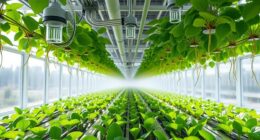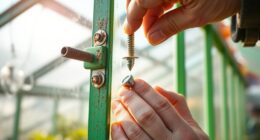When choosing sustainable materials for your greenhouse frame, opt for recycled metals like steel or aluminum, which are durable, recyclable, and often more affordable. Consider responsibly sourced or reclaimed wood for a eco-friendly alternative, but keep in mind it may need more maintenance. Metal frames resist weather and pests better, reducing long-term repairs. Exploring these options helps you build a resilient, environmentally friendly greenhouse—supporting sustainability while saving money over time. Keep exploring to discover more ways to make your structure eco-conscious.
Key Takeaways
- Prioritize recycled metals like steel or aluminum for durable, recyclable, and eco-friendly framing options.
- Choose responsibly sourced or reclaimed wood to ensure sustainability and reduce environmental impact.
- Consider metal frames with corrosion-resistant coatings for weather durability and long-term performance.
- Evaluate the full lifecycle costs, including maintenance and replacement, when selecting sustainable materials.
- Support circular economy practices by selecting materials that can be recycled or repurposed at end-of-life.

When building a greenhouse, choosing sustainable materials for the frame isn’t just an eco-friendly choice—it can also enhance durability and cost-effectiveness in the long run. The key is to select materials that not only minimize environmental impact but also stand the test of time. Recycling options play a significant role here; opting for recycled or recyclable materials means you’re reducing waste and making your project more sustainable overall. For example, metal frames made from recycled steel or aluminum are excellent because they’re highly durable and can be recycled again at the end of their lifespan. These materials resist rot, pests, and weathering better than many traditional options, which means fewer replacements and repairs, ultimately saving you money over time.
Material durability is vital when choosing a frame, as it directly affects the longevity of your greenhouse. You want a material that can withstand various weather conditions without degrading quickly. Recycled steel and aluminum are popular choices because they hold up well against corrosion, especially if properly coated or treated. Wood, while traditional, can be sustainable if sourced responsibly, but it often requires more maintenance and may not be as durable as metal options. If you opt for wood, consider reclaimed wood or fast-growing, sustainably harvested varieties to improve its environmental profile. However, keep in mind that wood may need regular treatment to prevent rot or pest damage, which could impact its overall durability and lifecycle costs. Incorporating recycling options into your material choice not only benefits the environment but can also provide cost savings. Reclaimed and recycled materials are sometimes more affordable and readily available, especially if you’re willing to repurpose existing structures or scrap materials. Additionally, some manufacturers produce frames with recycled content, which supports circular economy practices and reduces the demand for virgin resources.
Ultimately, when you prioritize sustainable materials with excellent recycling options and high material durability, you’re building a greenhouse that’s both environmentally responsible and built to last. This approach guarantees your investment remains resilient over time, reducing maintenance, replacement costs, and environmental footprint. By carefully evaluating the durability and recyclability of your chosen materials, you make a positive impact on the planet while creating a reliable environment for your plants to thrive.
Frequently Asked Questions
How Do Sustainable Materials Compare in Cost to Traditional Options?
Sustainable materials often have a higher initial cost than traditional options, but their durability and eco-friendly benefits can save you money in the long run. When doing a cost comparison, consider your budget considerations carefully—though green materials may require a larger upfront investment, they typically last longer and reduce maintenance costs. Ultimately, investing in sustainable options can offer better value and align with your environmental goals.
Are Sustainable Materials as Durable as Conventional Greenhouse Framing?
Sustainable materials can be just as durable as conventional options, but you should consider durability concerns and material lifespan. Many eco-friendly choices, like bamboo or recycled steel, are engineered for strength and longevity. While some may have a shorter lifespan initially, proper maintenance and treatment can prolong their durability. Ultimately, selecting high-quality sustainable materials ensures your greenhouse remains sturdy and long-lasting, aligning with your eco-conscious goals.
What Maintenance Is Required for Eco-Friendly Greenhouse Frames?
Maintaining your eco-friendly greenhouse frame is simple and sustainable. Regularly inspect for damage, and refresh eco-friendly paint to keep it vibrant and protected. Apply pest-resistant coatings to deter pests and prolong the frame’s lifespan. Clean surfaces with gentle, environmentally safe solutions to prevent buildup. Consistent care guarantees your frame stays strong, sustainable, and stylish, supporting healthy plants and a greener greenhouse environment.
Can Sustainable Materials Be Recycled or Reused Easily?
Yes, sustainable materials often have good reuse potential, making recycling easier. However, recycling challenges can arise due to material types or contamination, which may limit their recyclability. You can maximize reuse by selecting materials like recycled steel or bamboo, which are easier to recycle or repurpose. Being mindful of these factors helps guarantee your greenhouse frame remains environmentally friendly, reducing waste and supporting sustainability throughout its lifespan.
How Do Sustainable Frames Impact Overall Greenhouse Insulation?
Think of your greenhouse frame as a shield of sustainability; it directly influences thermal efficiency and structural integrity. A well-chosen, eco-friendly material acts like a sturdy armor, trapping warmth and preventing heat loss. This enhances insulation, keeps temperatures stable, and reduces energy costs. By selecting sustainable frames, you’re not just protecting your plants but also supporting a healthier planet, making your greenhouse a symbol of harmony between nature and innovation.
Conclusion
Just as a sturdy tree weaves its roots deep into the earth, your choice of sustainable materials anchors your greenhouse in harmony with nature. By selecting eco-friendly options, you’re planting seeds for a greener future, nurturing growth that endures through seasons. Remember, your greenhouse is more than a structure—it’s a living testament to your commitment. Choose wisely, and watch your green sanctuary flourish, rooted in sustainability and resilience, much like a mighty tree standing tall against the winds.


